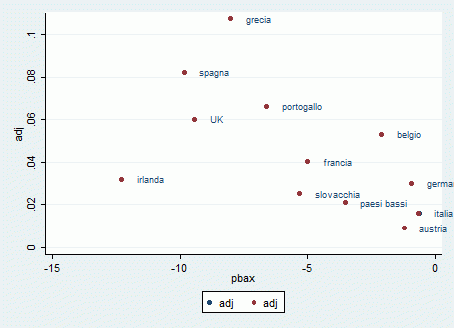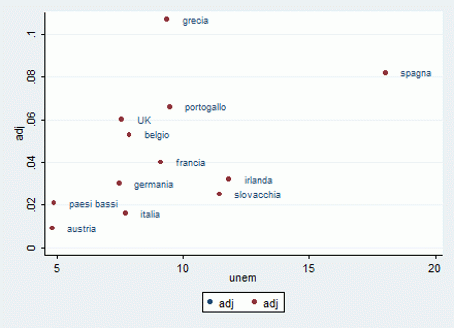Predictably, the recent G7/G20 summits in Canada sanctioned a compromise. On one side was the US-backed position that the fiscal stimulus should not be removed too prematurely and kill the recovery, on the other the EU-backed requirement that markets ought to be reassured on Europeans’ solvency (see Baldwin and Gros 2010 for the Eurozone).
Many observers have noted the "European" position, which focuses on fiscal discipline, mainly reflects the economic interests of Germany, a country that in recent years has witnessed strong gains in competitiveness and has managed to maintain a large external surplus in 2010 without compromising fiscal discipline (the debt ratio is currently at 79.6% and the primary budget at -3.5% of GDP). While German output fell by almost 5% between 2009 and 2010, the unemployment rate has actually dropped. It is therefore understandable that Germany, in order to stimulate the economy, would rather rely on productivity gains and on the depreciation of the euro, rather than footing the bill of fellow Europeans’ stimuli (and possible defaults).
In order to set a “good example”, the government of Angela Merkel recently introduced a constitutional rule requiring, from 2016, the federal structural deficit not to exceed 0.35% GDP, and constraining the German states to run balanced budgets. Similarly, budget "cuts" are on the agenda almost everywhere in Europe. The fiscal exit strategies differ from country to country, in terms of their size, their implementation horizon, their composition (spending cuts versus revenue increases), the nature of short- or long-term savings they generate, and the degree of institutional reforms that accompany them. Table 1 describes the size of budget cuts in relation to GDP of different national programmes for the period 2010-2015.
Table 1. Budget cuts (% GDP) for 2010-15 in Europe
|
Country
|
Adjustment
|
|
Austria
|
0.9%
|
|
Belgium
|
5.3%
|
|
France
|
4.5%
|
|
Germany
|
3.0%
|
|
Hungary
|
1.6%
|
|
Greece
|
10.7%
|
|
Ireland
|
3.2%
|
|
Italy
|
1.6%
|
|
Netherlands
|
2.1%
|
|
Portugal
|
6.6%
|
|
Slovakia
|
2.5%
|
|
Spain
|
8.2%
|
|
Switzerland
|
0.9%
|
|
Hungary
|
1.6%
|
|
UK
|
6.0%
|
Source: CESIFO
They range from the large adjustment's of France, Greece, Portugal, Spain, and the UK, to the modest cuts of Austria, Hungary, Italy, the Netherlands, and Slovakia (Ireland made large cuts prior to 2010 and therefore these do not appear fully in table).
Coordination or diktat?
These adjustment programmes pose an important question about fiscal policy in the Eurozone. To what extent are national policies the result of "policy coordination" in Europe and therefore meet, at least in part, "European" interests? Or do they obey the diktats of "fiscal dominance" from Germany, possibly under the implicit threat of leaving weak Southerners to their own destiny?
At this juncture, the “exit strategies” should strike a balance between three goals. The first one is the solvency of sovereigns. The second is the need to calibrate the exit strategies so as not to aggravate unemployment, the so-called "internal equilibrium”. The third, “European”, objective is the reduction of current-account imbalances within the Eurozone. Let us consider them in turn.
The solvency of sovereigns
If cuts are intended to ensure solvency, countries with lower primary surpluses should implement stronger manoeuvres. Figure 1 shows, on the y-axis, the magnitude of the cuts announced for 2010-15, and, on the x-axis, the primary balances in 2009. The figure shows that indeed a negative relationship seems to hold.
Figure 1. Budget cuts in 2010-15 (y-axis) vs. primary balances in 2009 (x-axis), % GDP
Source: Author’s calculations
In Figure 2, budget cuts are plotted against the debt/GDP ratios. Countries with more debt would require larger cuts in order to ensure solvency. The relationship between adjustment and debt is less clear cut. However, when the effects of other possible influences are controlled for, a positive relationship seems to hold.
Figure 2. Budget cuts in 2010-15 (y-axis) and public debt in 2009 (x-axis), % GDP
Source: author’s calculations
Unemployment
The consolidation measures in Europe do not appear to take unemployment into great consideration. Figure 3 shows the relationship between the cuts programmed for 2010-15 (on the y axis) and the rate of unemployment (on the x-axis) in 2009. In principle budget cuts should be lower where unemployment is higher. Yet, the figure shows that cuts are actually larger in countries where unemployment is higher.
Figure 3. Budget cuts in 2010-15 (x-axis), %GDP, and unemployment rate 2009 (y-axis)
Source: Author’s calculations
Current-account imbalances
The "European" objective of rebalancing current accounts in the Eurozone requires that the adjustment be larger for countries with the high current-account deficits. Clearly, this is because budget cuts tend to reduce aggregate demand, wages, and prices – thereby benefiting the trade balance. The policies undertaken by European countries seem to be consistent with this objective. Figure 4 shows that the adjustment tends to be larger for countries with larger current account deficits.
Figure 4. Budget cuts in 2010-15 (x-axis) and current-account balance 2009 (y-axis), % GDP
Source: Author’s calculations
Policy coordination or German diktat?
In conclusion, the fiscal exit strategies that the major European countries have planned for 2010-15 seem to respond to the need to ensure the solvency, being related to the levels of deficits and national debts. Despite the lack of formal mechanisms to implement fiscal coordination in the Eurozone, the planned exit strategy seems also consistent with the objective of promoting convergence among European countries, through the reduction of current-account imbalances. Thus, the view that fiscal consolidation in Europe merely responds to the interests of Germany seems excessive. Yet, the evidence also suggests that consolidation efforts do not reflect the unemployment situation of member countries, and appear inspired by a fiscal orthodoxy of Teutonic branding.
References






